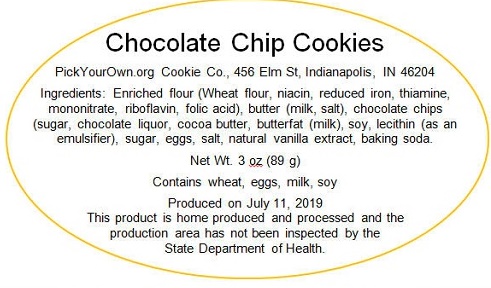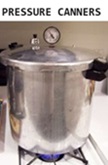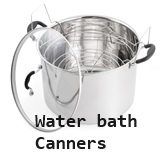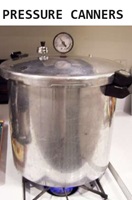
Looking for Indiana Cottage Food Laws and Regulations: How to sell your homemade foods in Indiana as a Home Based Vendor (HBV) in 2025? Scroll down this page and follow the links. And if you bring home some fruit or vegetables and want to can, freeze, make jam, salsa or pickles, see this page for simple, reliable, illustrated canning, freezing or preserving directions. There are plenty of other related resources, click on the resources dropdown above. If you are having a hard time finding canning lids, I've used these, and they're a great price & ship in 2 days.
If you have questions or feedback, please let me know! There are affiliate links on this page. Read our disclosure policy to learn more.
Indiana Cottage Food Laws and Regulations: How to sell your homemade foods in Indiana as a Home Based Vendor (HBV)
Indiana Cottage Food Laws, Regulations and Facts: “Home Based Vendors" (HBV)
Indiana changed their cottage food laws in 2022. The new law (HB 1149) was effective 7/1/22; code: IC 16-42-5.3, Date of the enactment of the original Indiana cottage food law: HEA 1309 passed in 2009 by Indiana Indiana has a broad definition of allowable food products. It is any food below a certain pH value or water activity level, which basically allows nearly any kind of non-potentially hazardous food. There is no registration, fees, or process to get setup, and there is no limitation to how much a vendor can sell, BUT the foods may only be sold at farmers markets and roadside stands within the state.
Which foods are allowed under the Indiana Cottage Food law?
Any food with a pH value of less than 4.6 and a water activity value of less than 0.85 is allowed by Indiana. This includes:
- Baked goods - cakes, fruit pies, cookies, brownies, dry noodles, cupcakes, bars, yeast breads, fruit breads, baguettes (no crème pies, no pumpkin pies)
- Candy and confections - caramels, chocolates, fudge, hard candy, peanut brittle, chocolate covered fruits, bon bons, buckeyes, chocolate covered nuts
- Produce - whole and unprocessed, unprocessed fruits and vegetables (i.e) cherries, blackberries, cranberries, grapefruit, strawberries, oranges, blueberries, plums, tomatoes
- Tree nuts and legumes
- Pickled cucumbers processed in a traditional fermentation method (no vinegar or other acidifier added and open containers)
- Honey, molasses, sorghum, maple syrup
- Jams, jellies, preserves - only high acid fruit; although they may be temperature controlled only for quality as long as it is not needed for safety or to prevent spoilage
- Dry goods, like Cereals, dry Herbs, dry mixes, dry pasta noodles, dry Spices and Seasonings, Coffee beans, Tea leaves
- In-shell chicken eggs (with Egg Board license and labeling)
- Some rabbit, aquatic products and poultry (with restrictions)
- SOME dehydrated fruits and vegetables: It depends on the fruit. It is recommended that you reach out to Purdue Food Science (764-494-8256) for testing and your local health department
- Mushrooms grown as a product of agriculture are not restricted from sale. Uncultivated (wild) mushrooms must be certified in writing by a “Mushroom Expert” as registered with the State of Indiana
Prohibited Foods:
HBV products in their final form cannot not be a potentially hazardous food. HBV food products may not contain ingredients in any form which have a component of:
- Meat, (rabbit is permitted with restrictions)
- Poultry, (permitted with restrictions)
- Aquatic animal products, (permitted with restrictions)
- Dairy (including cheese, butter, yogurt, in a product that needs refrigeration. This does not include baked items such as cakes and cookies)
- low sugar jams and jellies,
- Acidified foods
- pumpkin and pear fruit butters,
- Meat (domestic or wild)
- Poultry
- Aquatic animal products
- Dairy (including raw milk), Excluding some baked items and dried
- Egg products, Excluding some baked items and dried noodles
- Shell eggs, like duck, quail, and turkey, which are not from a domestic chicken
- Using of "reduced oxygen packaging" (ROP) methods
- Canned or hermetically sealed containers of acidified (such as pickles, salsa, chutney, chowchow, pickled green beans, pickled beets)
- A “canned” or “hermitically sealed container” of low-acid food, (i.e. packaged cooked; example canned tomatoes,)
- Cut melons
- Raw seed sprouts
- Non-modified garlic-in-oil mixtures
- Cut tomatoes and cut leafy greens (salads)
Where can an HBV Cottage Food Operations make their food products?
HBV's may produce the food products in their primary residence, (a "domestic residence") which may be a single-family dwelling or an area within a rental unit where a single person or family actually resides (including a mobile home, if you actually live in it).
Products can, however, be made in a building outside the residence but still on the vendor’s property (which could be a barn or shed). But, of course, we're talking about a hygienic barn or shed, made into a safe, clean kitchen workplace.
You may not use a rental kitchen or facility as that is considered a food business and requires a license.
HBV products must be produced in your primary residence, which could include a mobile home IF that is your primary residence.
No commercial kitchens: If you
use a commercial kitchen to make your products you are then operating as a Food Business and need to be licensed.
See
IAC 7-24 “Retail Food Establishment Sanitation requirements.” and See applicable
U.S. Federal Food laws here. This
Indiana Guide, How to Start a Retail Food Business,
may be helpful.
Where may HBV Cottage Food Operations sell the food products?
Cottage Food Products may only be sold within the state.
All products must be sold direct to consumer. You may not sell through a grocery store or other store since that would be considered wholesale and requires a permit and inspected kitchen
Prior to July 2022, They could only be sold directly to the consumer at registered farm markets and roadside stands. That was it; nowhere else.
Since July 2022, home based food products can be sold directly to end consumers. That can be:
- In person
- By phone, or
- Through the internet (Records for products that are shipped or mailed to end users must be maintained for at least one year after the date of sale. These records can be in electronic or paper form.)
- Sold direct to consumers (by the HBV) at at farmer's market or roadside stand
A roadside stand is defined as "A place, building, or structure along, or near, a road, street, lane, avenue, boulevard, or highway where a HBV sells food product(s) to the public."
Delivery is allowed to the end consumer
- in person,
- by mail, or
- by a third-party carrier
Delivery is not allowed:
- "a home based vendor may not ship or deliver food product to an end consumer who is located outside of Indiana.
How much may an HBV sell?
There is not currently (as of Jan 2024) a limit on amount of sales.
If your food product does not meet the definition of a Cottage Food:
Don't give up. You may still be able to make and sell it commercially, through a startup approach.
First, you may be able to rent space in a local licensed commercial kitchen.
Second, if that doesn't work, you may be able to get a co-packer to make the food for you.
Definitions:
- “Home Based Vendors (HBV)” means a person who produces food products only in the home kitchen of that person’s primary domestic residence and only for sale directly to the consumer at Farmer’s Market or Roadside Stand. A home-based vendor operation shall not operate as a food service establishment, retail food store, or wholesale food manufacturer, and cannot produce food in a commercial kitchen.
- An HBV can produce non-potentially hazardous baked goods, jams, jellies, and other non-potentially hazardous foods.
- “Domestic Residence” means a single-family dwelling or an area within a rental unit where a single person or family actually resides. The new law states that products must be made on the vendor’s primary residence. Products can, however, be made in a building outside the residence but still on the vendor’s property (i.e. barn or shed). A domestic residence does not include any group or communal residential setting within any type of structure, or outbuilding, shed, barn, or other similar structure. You may not use a rental kitchen or facility as that is considered a food business and requires a license. HBV products must be produced in your primary residence
- “Potentially hazardous food (sometimes referred to as “TCS” or time/temperature
control for safety food)” means a FOOD that is held at a specific temperature range that limits pathogenic microorganism growth or toxin
formation from that growth. These are foods any food that is natural or synthetic and requires temperature control and potentially hazardous
because it is in a form capable of supporting any of the following- The rapid and progressive growth of infectious or toxigenic microorganisms
- The growth and toxin production of Clostridium botulinum (botulism)
- The growth of Salmonella enteritidis (raw shell eggs)
- A food of animal origin that is raw or heat treated
- A food of plant origin that is heat treated or consists of raw seed sprouts
- Cut melons, tomatoes, and lettuce
- Garlic-in-oil mixtures that are not modified in a way that results in mixtures that do not support growth described in subsection
- “Hermitically sealed” means food that is packaged in cans or glass jars and has no oxygen exchange with the atmosphere.
- Farmers' market: a common facility where
two or more farmers or growers gather on a regular recurring
basis to sell a variety of fruits,vegetables and other farm
products directly to consumers. It can be combined with other
events, but must be with
the farmer's market and it must not be an individual produce market operated by a person or company. - Roadside stand: a place, building, or structure along, or near, a road, street, lane, avenue, boulevard, or highway where a HBV sells food product(s) to the public. This does NOT include the HBV's residence or a regulated food establishment.
Packaging Requirements
HBV food products may not be packaged using:
- Packaging considering to be “canned” or hermitically sealed” . This includes home canning, inversion canning, etc.
- The “reduced oxygen packaging” or ROP method, such as the use of a vacuum packaging machine
Labeling requirements
Cottage Food Production Operations must label all of their food products properly, which include the following information on the label of each unit of food product offered or distributed for sale:
HBV food products must be labeled and the label must include the following:
- Producer's name and address
- Common name of food product
- Ingredients of food product, in descending order by predominance by weight
- Net weight and volume of the food product by standard measure or numerical county
- Date food product was processed
- The
following statement in 10 point type:
"This product is home produced and processed and the production area has not been inspected by the State Department of Health." - If you are selling online, the food product label must be available on your webpage/market website
Placards
In place of labeling on the product a placard may be used in some situations; in other words, Unpackaged foods should be considered “labeled” when there is an easily readable sign in at least 10 point type accompanying the food product::
- When the product sold is not packaged
- Must contain all the same required labeling information
- Labeling is encouraged in most situations
- Food products being provided to consumers as open samples can be considered to be labeled when there is a nearby container of the same product labeled according to section 29(b)(5)
Here is a free Microsoft Word label template which you can download and edit. These labels are already formatted to fit on Avery Template 22820 Print-to-the-Edge Oval, Labels 2" x 3-1/3", 8 per Sheet, Glossy White. You can get the label stock online (see at right).
Depending on the size of your business, your label must comply with Federal label regulations and with the new nutritional labeling law. You can download a copy of the FDA Food Labeling Guide here it s an illustrated booklet that should answer all your questions.
Training Requirements: Food Handler Certification
All home based vendors are required to obtain a food handler certificate from a certificate issuer that is accredited by the ANSI.
Upon
request, the home-based vendor must provide a copy of the certificate to the state department or end consumer
There are both in-person and online courses. See the boxes at right below:
Take the
ServSafe® training classes for Manager and employees, the 7th Edition Book that accompanies this course should be purchased here..
Other requirements
Get the Servsafe and CPFM Study Guide for Food Manager Certification in Paperback
And get the ServSafe Food Handler Guide
The basics of HBV's:
- may only sell non-potentially hazardous food products (as defined above) made in their primary residence with limited regulatory oversight
- must meet the requirements listed in statute
- Either HBV or Food establishment, not both: The HBV cannot comingle the activities of HBV food production and activities of a food establishment. If a HBV sells food products other than those produced in the home, it becomes a food establishment. One is either an HBV or a food establishment, not both.
- No resale: The food product of a HBV may not be resold and is subject to the laws of the state and the Federal Food, Drug & Cosmetic Act and legally cannot be sold in Indiana.
- Record keeping: Records for products that are shipped or mailed to end users (customers) must be maintained for at least one year after the date of sale. These records can be in either electronic or paper form.
- Inspections: The regulatory authority may examine HBV food products and products labeling when being offered for sale to ensure they are in fact in compliance with the new law to maintain their exemption. If the Indiana Department of Health receives any complaints or concerns about non-compliance or food safety issues, the department may inspect your kitchen.
- Samples may be taken by inspectors: HBV are subject to regulatory sample collection, inspection, investigation, and other enforcement activities as required by law.
Additional requirements for meat
If an HBV product sold at the farmers market or roadside stands include one of the following, these specific procedures must be followed:
- Meat
i. Allowed: Animals must be taken to a licensed USDA facility to be processed and packaged. After packaging at the facility, the vendor must sell the meat/ poultry in original packaging with pack date and facility information on label or packaging. Must be kept frozen and sold frozen.
ii. Not allowed: Any food that has been directly handled or processed in any way by the vendor. For example, a HBV cannot sell jerky. - Poultry:
i. Allowed: Up to 1000 birds is considered a Home-Based Vendor, however over 1000 or more birds, the HBV must contact Meat and Poultry Division of the Indiana State Board of Animal Health (BOAH).
All poultry produced and sold at a farmer’s market or roadside stand must be sold FROZEN.
Note, the food rules are different for farms (as defined by the state): Poultry produced and sold at a farm must be refrigerated or frozen at the point of sale
In-shell chicken eggs can also be sold after receiving the approval and Farmer’s Market license from the Indiana State Egg Board. - Rabbit:
i. Allowed: Must be slaughtered and processed on the farm, and sold only at a farmer’s market, or at a roadside stand. Rabbit must be sold FROZEN at a farmer’s market or roadside stand - Aquatic Animal Product:
i. Allowed: Fish and shrimp must arrive alive at the farmer’s market or roadside stand, and products must be placed immediately on ice.
Specific requirements for offering food samples:
HBV's may provide samples of their food products to a consumer. The individual offering samples must “practice proper sanitary procedure” as follows:
- Proper hand washing station and waste bucket for both dirty water and used paper towels.
- Sanitation of the container or other packaging in which the good product is contained;
- The food product samples must be safely stored and presented, which would include protection during display and services, such as single portion service of samples for individual consumers (use of cups, utensils, tongs, and wax paper)
- Sampling at a roadside market and/or farmer’s market does not include assembling of two (2) or more HBV food products to produce an additional food product. (i.e. HBV food product “strawberries” plus HBV food product “pound cake” cannot be combined to make another HBV food product, such as a “strawberry shortcake”.
- See placards under labeling above
FAQs
Recommendations:
Beyond the requirements, common sense, good practices and reducing liability suggests you should do the following.
Testing of pH
It's best to use a pH meter, properly calibrated on the day
used. I use this one, which is reliable and inexpensive.
And this pH meter is really good, but isn't always available.
Short-range paper
pH test strips, commonly known as litmus paper, may be used
instead, if the product normally has a pH of 4.0 or lower and the
paper's range includes a pH of 4.6.
Record-keeping is suggested
Keep a written record of every batch of product made for sale, including:
- Recipe, including procedures and ingredients
- Amount canned and sold
- Canning date
- Sale dates and locations
- Gross sales receipts
- Results of any pH test
Sanitation
Although inspections are not required, you should consider doing the following:
- Use clean equipment that has been effectively sanitized prior to use
- Clean work surfaces and then sanitize with bleach water before and after use
- Keep ingredients separate from other unprocessed foods
- Keep household pets out of the work area
- Keep walls and floors clean
- Have adequate lighting
- Keep window and door screens in good repair to keep insects out
- Wash hands frequently while working
- Consider annual testing of water if using a private well
Best Practices
- Allergens: Most state home baking
acts require an "ingredient statement" and/or an "allergen
listing" on the label of the bakery item for sale; but if your
state does not, you should anyway. The eight major food
allergens are
- milk,
- eggs,
- fish,
- crustacean shellfish,
- tree nuts,
- peanuts,
- wheat and
- soybean.
- Cross-allergenicity: There are also ingredients available, even flours, that can cause a cross-allergenicity. The American Academy of Allergy Asthma & Immunology explains cross-allergenicity as an allergic reaction when proteins in one substance are similar to the proteins found in another substance. For example, consumption of lupine flour may trigger an allergic reaction to peanuts, and cricket flour may trigger an allergic reaction to shellfish. Again, providing such information might be a beneficial marketing tool and help keep potential consumers safe.
- The 2 Hour/4 Hour Rule - Anyone
wishing to make and sell refrigerated bakery items should
remember to follow the "2 Hour/4 Hour Rule." This is a system
that can be implemented when potentially hazardous foods are out
of temperature control (temperatures greater than 45 degrees
Fahrenheit) during preparation, serving or display for sale. The
rule guidelines are as follows:
- If a potentially hazardous food has been out of temperature control for 2 hours or less, then it may continue to be used or be placed back in the refrigerator.
- If a potentially hazardous food has been out of temperature control for more than 2 hours but less than 4 hours, it needs to be used quickly or discarded.
- If a potentially hazardous food has been out of temperature control for more than 4 hours, it must be discarded.
More resources:
- Overview of Indiana's Cottage Food program, from the state of Indiana
- Indiana Home-Based Vendor Program.
- Indiana state and local health department contact information.
Questions? Contact Information:
Indiana State: Phone: 317-233-1325.
Lisa Harrison, ISDH Training Specialist
100 N. Senate Ave. Room N855
Indianapolis, IN 46204
317-234-8569
lharriso@isdh.in.gov
- Your local health department
- Indiana Dept. of Health 317-234-8569
- Indiana Board of Animal Health 317-544-2400
- Indiana State Egg Board 765-494-8510
- Purdue Food Science Dept. 764-494-8256
Looking for canning equipment and supplies?
Water bath canner with a jar rack
Pressure canners for gas, electric and induction stoves: Presto 23Qt or T-fal 22Qt
Canning scoop (this one is PERFECT)
Ball Blue book (most recent version)
Jars: 8oz canning jars for jams
Find Other types of farms:
Farm markets and roadside stands
Road trips and camping resources
Local Honey, apiaries, beekeepers
Consumer fraud and scams information
Home canning supplies at the best prices on the internet!
Maple Syrup Farms, sugarworks, maple syrup festivals
Environmental information and resources
Farms For Your Event for birthday parties, weddings, receptions, business meetings, retreats, etc.
Festivals - local fruit and vegetable festivals
Get the
most recent version of
the Ball Blue Book
With this Presto 23 quart pressure canner and pressure cooker, you can "can" everything, fruits, vegetables, jams, jellies, salsa, applesauce, pickles, even meats, soups, stews. Model 01781

You can make jams, jellies, can fruit, applesauce, salsa and pickles with water bath canners, like this Granite Ware 12-Piece Canner Kit, Jar Rack, Blancher, Colander and 5 piece Canning Tool Set

